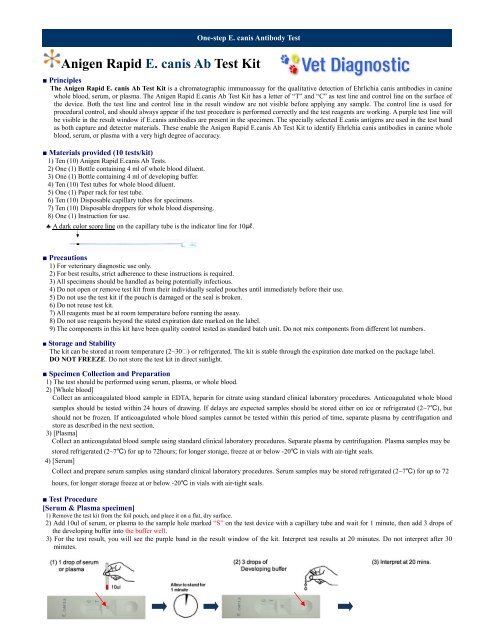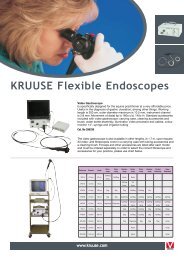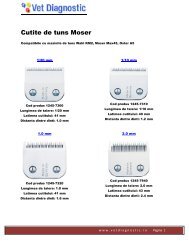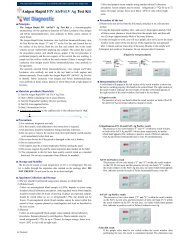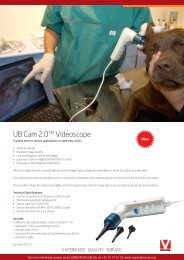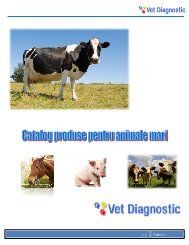Anigen Rapid E. canis Ab Test Kit - Vet Diagnostic
Anigen Rapid E. canis Ab Test Kit - Vet Diagnostic
Anigen Rapid E. canis Ab Test Kit - Vet Diagnostic
- No tags were found...
Create successful ePaper yourself
Turn your PDF publications into a flip-book with our unique Google optimized e-Paper software.
<strong>Anigen</strong> <strong>Rapid</strong> E. <strong>canis</strong> <strong>Ab</strong> <strong>Test</strong> <strong>Kit</strong><br />
■ Principles<br />
The <strong>Anigen</strong> <strong>Rapid</strong> E. <strong>canis</strong> <strong>Ab</strong> <strong>Test</strong> <strong>Kit</strong> is a chromatographic immunoassay for the qualitative detection of Ehrlichia <strong>canis</strong> antibodies in canine<br />
whole blood, serum, or plasma. The <strong>Anigen</strong> <strong>Rapid</strong> E.<strong>canis</strong> <strong>Ab</strong> <strong>Test</strong> <strong>Kit</strong> has a letter of “T” and “C” as test line and control line on the surface of<br />
the device. Both the test line and control line in the result window are not visible before applying any sample. The control line is used for<br />
procedural control, and should always appear if the test procedure is performed correctly and the test reagents are working. A purple test line will<br />
be visible in the result window if E.<strong>canis</strong> antibodies are present in the specimen. The specially selected E.<strong>canis</strong> antigens are used in the test band<br />
as both capture and detector materials. These enable the <strong>Anigen</strong> <strong>Rapid</strong> E.<strong>canis</strong> <strong>Ab</strong> <strong>Test</strong> <strong>Kit</strong> to identify Ehrlchia <strong>canis</strong> antibodies in canine whole<br />
blood, serum, or plasma with a very high degree of accuracy.<br />
■ Materials provided (10 tests/kit)<br />
1) Ten (10) <strong>Anigen</strong> <strong>Rapid</strong> E.<strong>canis</strong> <strong>Ab</strong> <strong>Test</strong>s.<br />
2) One (1) Bottle containing 4 ml of whole blood diluent.<br />
3) One (1) Bottle containing 4 ml of developing buffer.<br />
4) Ten (10) <strong>Test</strong> tubes for whole blood diluent.<br />
5) One (1) Paper rack for test tube.<br />
6) Ten (10) Disposable capillary tubes for specimens.<br />
7) Ten (10) Disposable droppers for whole blood dispensing.<br />
8) One (1) Instruction for use.<br />
One-step E. <strong>canis</strong> Antibody <strong>Test</strong><br />
♣ A dark color score line on the capillary tube is the indicator line for 10μl.<br />
■ Precautions<br />
1) For veterinary diagnostic use only.<br />
2) For best results, strict adherence to these instructions is required.<br />
3) All specimens should be handled as being potentially infectious.<br />
4) Do not open or remove test kit from their individually sealed pouches until immediately before their use.<br />
5) Do not use the test kit if the pouch is damaged or the seal is broken.<br />
6) Do not reuse test kit.<br />
7) All reagents must be at room temperature before running the assay.<br />
8) Do not use reagents beyond the stated expiration date marked on the label.<br />
9) The components in this kit have been quality control tested as standard batch unit. Do not mix components from different lot numbers.<br />
■ Storage and Stability<br />
The kit can be stored at room temperature (2~30 ) or refrigerated. The kit is stable through the expiration date marked on the package label.<br />
DO NOT FREEZE. Do not store the test kit in direct sunlight.<br />
■ Specimen Collection and Preparation<br />
1) The test should be performed using serum, plasma, or whole blood.<br />
2) [Whole blood]<br />
Collect an anticoagulated blood sample in EDTA, heparin for citrate using standard clinical laboratory procedures. Anticoagulated whole blood<br />
samples should be tested within 24 hours of drawing. If delays are expected samples should be stored either on ice or refrigerated (2~7℃), but<br />
should not be frozen. If anticoagulated whole blood samples cannot be tested within this period of time, separate plasma by centrifugation and<br />
store as described in the next section.<br />
3) [Plasma]<br />
Collect an anticoagulated blood sample using standard clinical laboratory procedures. Separate plasma by centrifugation. Plasma samples may be<br />
stored refrigerated (2~7℃) for up to 72hours; for longer storage, freeze at or below -20℃ in vials with air-tight seals.<br />
4) [Serum]<br />
Collect and prepare serum samples using standard clinical laboratory procedures. Serum samples may be stored refrigerated (2~7℃) for up to 72<br />
hours, for longer storage freeze at or below -20℃ in vials with air-tight seals.<br />
■ <strong>Test</strong> Procedure<br />
[Serum & Plasma specimen]<br />
1) Remove the test kit from the foil pouch, and place it on a flat, dry surface.<br />
2) Add 10ul of serum, or plasma to the sample hole marked “S” on the test device with a capillary tube and wait for 1 minute, then add 3 drops of<br />
the developing buffer into the buffer well.<br />
3) For the test result, you will see the purple band in the result window of the kit. Interpret test results at 20 minutes. Do not interpret after 30<br />
minutes.


